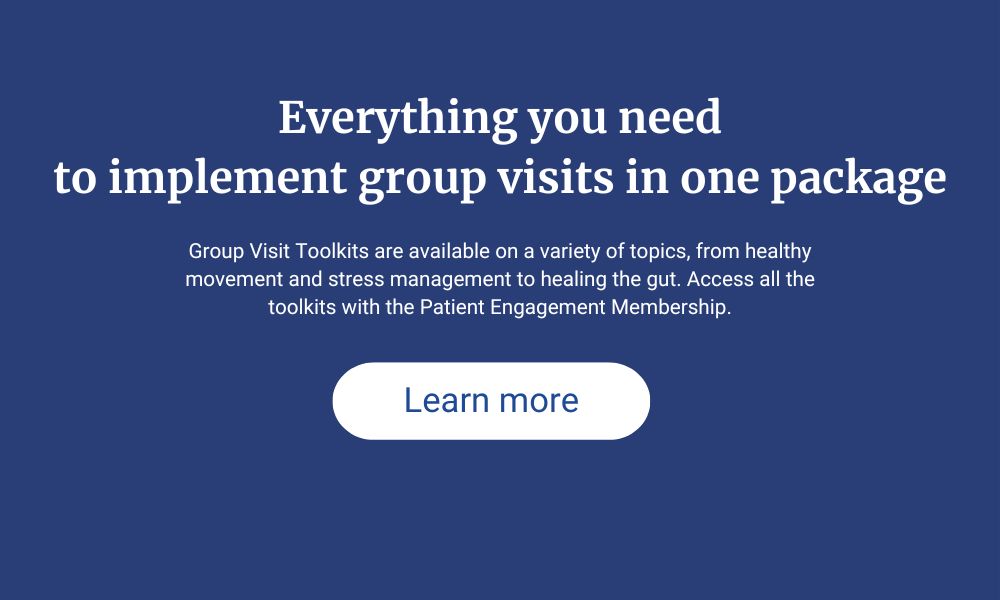Group medical visits, also called shared medical appointments, are practitioner-patient medical encounters in which a group of people are seen together in a concurrent session. Although the individual, face-to-face appointment continues to be the prevailing model of patient care, mostly by default, there is growing evidence that suggests group visits are effective and provide benefits above and beyond an individual encounter.
9 Benefits of Group Medical Visits
A 2017 article identified nine key elements that demonstrate how group visits transform the practitioner-patient experience and improve outcomes.
- Group formats combat isolation, which secondarily improve a patient's sense of self-efficacy and their belief in their capacity to execute behaviors necessary to produce specific performance attainments (e.g., initiate and sustain practitioners' recommendations).
- Patients learn vicariously about disease risk factors and management by witnessing others’ experiences, especially in lifestyle-based groups.
- Patients feel inspired by seeing others who are coping or succeeding with a similar condition to their own.
- The group dynamic fosters equitable relationships between patients and practitioners.
- Multiple practitioners or educators working together increases team cohesion and service coordination. This leads to increased work satisfaction and enhanced working relationships.
- Practitioners learn to better support patients' needs through increased brainstorming and dialogue around recommendation implementation.
- Patients feel more supported because group visit appointments generally last longer than individual appointments in conventional settings.
- Patients acquire more robust health knowledge through professional expertise from practitioners and first-hand experience from peers.
- Patients develop greater trust in their practitioners by having the opportunity to see their medical team interact with fellow patients, allowing them to get to know their practitioners and better determine their level of trust. This expanded trust may also explain the improved compliance seen among group visit patients as compared to their individual appointment counterparts.
6 Group Visit Challenges and Solutions
This list is certainly compelling, and it may make you wonder, “Why aren’t more practitioners implementing group visits?” Despite the known clinical, operational and financial benefits of the group visit model, many functional and integrative practitioners resist implementation. Here are the most common challenges that prevent the incorporation of group visits and powerful, effective strategies to overcome them.
1. Lack of Group Visit Training
Although this might be a real concern for implementing the group visit model, it is true of anything new implemented in our practices, whether it's a new therapy, procedure or practice management style. The goal, like other new ideas, is to learn how to integrate it as a standard and then personalize it to your particular practice setting and patients.
The LMRC is a great resource for practitioners, and their Practice Consultants who offer assistance to LMRC members can provide the expertise and materials to overcome this concern.
2. RVU Generation
Many health care trends forecast that costs eventually will not be based on quantity or productivity (i.e., the RVU model) but on quality (i.e., pay-for-performance model). Furthermore, most integrative or functional medicine practices are smaller settings that do not commonly use RVU generation in their billing and compensation formulas.
3. Staffing Concerns
Group visits are designed to be implemented with the current staff of a practice. There are ways that a practice can independently contract out other consultants, like a health coach, or partner with local practitioners (e.g., a behaviorist or nutritionist) to design a model that works for patients and practitioners. Again, the team at LMRC is trained to personalize solutions for any practice interested in leveraging time by using group visits.
4. Lack of Space
Many practices conduct group visits in an on-site conference room or the lobby of their current office space at the beginning or end of the workday. For insurance-based practices, it is a requirement to have the group visit at the same site as the insurance contracts.
However, cash-based group visits are not as restrictive. Many will use the Group Visit Toolkits “on the road” at health food stores, yoga studios, etc. and may also convert them into online educational or marketing tools.
5. Not Enough Time
Time scarcity during the workday is a common complaint among medical staff. Group visits actually solve this problem, although many practitioners use it as a reason to avoid implementing group visits. Seeing 10-20 patients with similar concerns in a 90-minute group appointment frees up time in the workday. Some practices choose to use the extra time made available by group visits to see more patients while others choose to enjoy a calmer pace in the office.
6. Low Patient Interest or Recruitment
Group visits are a new concept to both patients and practitioners. However, just like with a new supplement or service, once we see that the offering would further our patient and practice goals, we promote it accordingly. This practice management innovation is no different. Use the same muscle you flex with other functional therapies and prescribe this type of visit in the same way. Your recommendation and passion may be the missing link.
Take the Next Steps to Host Group Visits
In general, it is entirely human to stay the course with what seems to be working “well enough.” However, upon reflection, most will admit there is room for improvement, and a new approach makes a difference. Individual appointments are essential to the patient-provider experience. However, group visits offer the “social nutrition” that just can’t be created one-on-one. The truth is, if you are reading this, you are likely already a pioneer. All that is left is to do what you know would make a difference for the clinical, operational and financial health of your practice.
Based on your expertise, available time and office culture, the Lifestyle Matrix Resource Center will help you create a personalized implementation strategy that works for you. The health care movement needs pioneers to shift the collective needle. The evidence is clear that the group visit model is vital in leveraging lifestyle and functional medicine to reach more patients and build healthy, supportive communities.

Shilpa P. Saxena, MD, IFMCP is a board-certified family physician with an uncompromising commitment to make functional medicine the new healthcare.
Dr. Saxena serves as Chief Medical Officer at Forum Health while maintaining her patient care skills at their Tampa location. As a practicing physician for over 20 years, she loved to share her clinical, financial, operational, and technological expertise as faculty with the Institute for Functional Medicine, the Andrew Weil Center for Integrative Medicine, George Washington University’s Metabolic Medicine Institute, University of Miami Miller School of Medicine’s Department of Family Medicine and Community Health, and Universidad San Ignacio de Loyola (Lima, Perú).
Dr. Saxena is a long-standing team member at the Lifestyle Matrix Resource Center team serving as a Practice Growth and Cardiometabolic Medicine Expert. Her classic keep-it-simple and heartwarming style of teaching continues to make her one of the most effective and loved educators in the field.




